
S2G Summit: Insights on Financing the Transition


It was a pleasure gathering our community again for the 7th annual S2G Summit. In addition to catching up with old friends and meeting some new ones, it was a chance to reflect on the opportunities and risks for the food, agriculture, oceans, and energy transitions presented by the current global landscape. Below we offer highlights of the second day of the summit. Read our highlights of Day One.
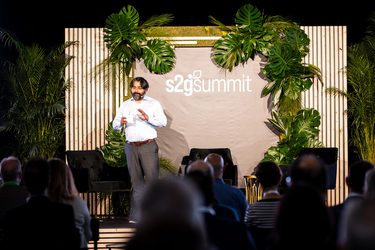
S2G’s Sanjeev Krishnan kicked off the day with a whirlwind exploration of financing the transition and how Summit would tackle different aspects of this effort. He shared his perspective on navigating through an era of unprecedented volatility and inflation, driven by significant geopolitical disruptions, increasing digitization, climate change, demographic shifts towards a ten billion-strong aging population, and complex capital market dynamics. These transitions have second- and third-order impacts, particularly pronounced in commodity systems that are increasingly vulnerable to external shocks.
Despite these challenges, there are innovative solutions that are more efficient and affordable and less volatile and vulnerable. Krishnan stressed the importance of viewing the current transformations at a systemic level, acknowledging the historical context and future potential. While large incumbents, or “tankerships,” dominate these sectors, S2G is working to fund “speedboats” that we believe can propel changes in those larger companies and our sectors of focus more broadly. But we believe change requires alignment on a number of dimensions: engaging with industry incumbents, community and storytelling, technological advancements and business model innovation, and fit-for-purpose capital markets.
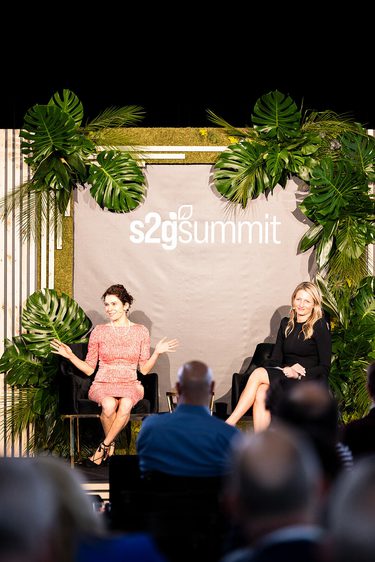
Engaging with Industry Incumbents
Sustainable Shifts: Identify Missteps, Harness Trends, and Craft Solutions
Meade Harris, CEO of Dynamo Energy Hub, interviewed Sophia Mendelsohn, Chief Sustainability Officer and Commercial Officer at SAP Sustainability, on the evolving dynamics of sustainability within corporate strategies. Mendelsohn highlighted past missteps in sustainability efforts, including the risk of discounting climate risk in value chains. She emphasized the need to move away from positioning sustainability as a regulatory necessity to highlighting the market opportunity. In her view, with the costs of supply chain inputs rising and technology decreasing, it is time to shift resources from focusing on “how to source more cheaply” to “how we can source differently.”

Community and Storytelling
Book Stage and Screen: Scaling Important Messages Across Audiences and Media
In this conversation, Anthony Abbenante, Managing Director of RRG Solutions, spoke with Kevin Kwan, author of the No.1 New York Times Bestselling “Crazy Rich Asians” trilogy, and John Penotti, Film Producer and President at Penotti Pictures, about their journey of overcoming industry skepticism to bring a culturally significant story to the mainstream.
Kwan and Penotti spoke about the systemic barriers they faced in Hollywood, fueled by doubt about the commercial viability of an all-Asian cast. Kwan emphasized the importance of thinking outside the box and leveraging his deep understanding of his audience to drive the project forward, while Penotti drew on his experience in independent filmmaking to persevere despite rejections from mainstream studios. The duo took a significant risk by pursuing a less lucrative theatrical release over a Netflix deal, highlighting their belief in the film’s broader cultural impact. Despite initial setbacks, their commitment to authenticity and engaging storytelling ultimately led to the film’s success.
In addition to providing interesting insight into the world of filmmaking, the conversation also highlighted its entrepreneurial nature. Many movie projects function similarly to startups that require rigorous iteration and strategic risk-taking. Kwan’s confidence in his audience and his efforts to make the story universally personal were pivotal in garnering support, demonstrating how specificity in storytelling can foster widespread engagement and success.
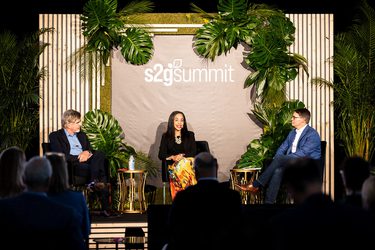
Driving Forces: Building Mindshare and Mobilizing People for Good
Tom Freston, Board Chair and Principal at Firefly3 and former CEO and COO at Viacom Inc, and Ndidi Nwuneli, President and CEO of The ONE Campaign, shed light on the importance of systemic thinking in addressing global challenges. The ONE Campaign is an international, non-partisan advocacy and campaigning organization that fights extreme poverty and disease, particularly in Africa.
Freston and Nwuneli stressed the immense scale of these challenges and their work to change the narrative around African economies, emphasizing the importance of leveraging popular culture and engaging younger generations. By tapping into platforms like TikTok and hip-hop, they have galvanized movements and created cultural phenomena that drive change, even in a polarized digital world. They spoke about breaking down frictions by adopting a systems-wide approach and being one step ahead, ensuring that efforts are demand-driven and low-cost with resilience built into its DNA — engaging stakeholders with compelling storytelling.
Nwuneli emphasized that we should never underestimate what we can accomplish through partnerships as well as when we leave our egos at the door and are not focused on who gets the credit. She challenged attendees to think about the most vulnerable person who can benefit from an intervention, ensure diversity of ideas in board and community focus groups, and move beyond ESG to ask how we can leave a lasting legacy.
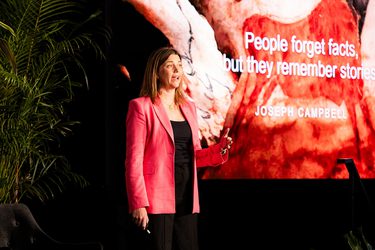
Natural Stories: Why Authentic Stories Matter
Kaitlin Yarnall, Chief Storytelling Officer at National Geographic Society, delivered a visually stunning and inspiring presentation on the profound impact of authentic storytelling in advancing sustainability and environmental initiatives. Yarnall emphasized that powerful narratives have the unique ability to bridge the gap between complex scientific data and public understanding, fostering a deeper connection and engagement with critical environmental issues.
Citing successful campaigns and projects, Yarnall showcased how National Geographic’s commitment to authenticity has catalyzed meaningful dialogue and tangible outcomes in conservation and sustainability efforts. She underscored the indispensable role of interdisciplinary collaboration among journalists, scientists, and local communities in creating compelling stories that resonate globally. Yarnall argued that genuine narratives rooted in real-world experiences and scientific rigor are essential for building trust and credibility with diverse audiences. Her presentation provided the audience with a nuanced understanding of how strategic storytelling can be a powerful tool in driving sustainable innovation and fostering an informed, engaged public.
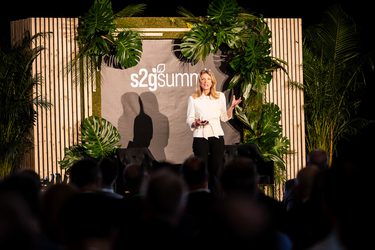
Innovations and Business Model Innovation
Scaling New Energies Sustainably
Cynthia J. Warner, Senior Operating Partner at GVP Climate, shed light on the inherent risks and opportunities across the energy transition landscape. Drawing from an in-depth study on the technological boom of 2010, where 81 percent of new technologies failed to meet customer expectations, Warner emphasized the necessity of ensuring sustainability from a technology and economic standpoint. Some of the unique challenges energy startups face include competing with economies of scale, the high costs of scaling up, and the difficulty of integrating into an extensive and complex value chain.
To address these obstacles, she shared how the audience can think about derisking the energy transition through several approaches including having science on your side, using all available advantages, understanding economic drivers, and optimizing the path and scope of scaleup. By drawing on past experiences, Warner advocated for a balanced approach towards scaling new energy solutions, highlighting the importance of speed to market while ensuring standalone profitability. She encouraged attendees to embrace problems as opportunities, fostering an optimistic yet realistic mindset crucial for navigating the future of sustainable energy.

Maritime Infrastructure: The Role of Cross-Sector Innovation in the Transition
In this session, Julian Proctor, CEO of S2G portfolio company Purus, discussed the market opportunity around maritime infrastructure and how Purus is tackling the challenge. Proctor believes there is no one-size-fits-all solution for decarbonizing the maritime sector, which accounts for three percent of global greenhouse gas emissions. Many alternative fuels and technologies are expensive and require infrastructure, capital, time, and coordination to implement at scale. Simultaneously, the International Maritime Organization requires vessels to abide by more stringent emissions regulations. Purus takes a technology-agnostic and customer-centric approach to support decarbonization across the maritime industry.
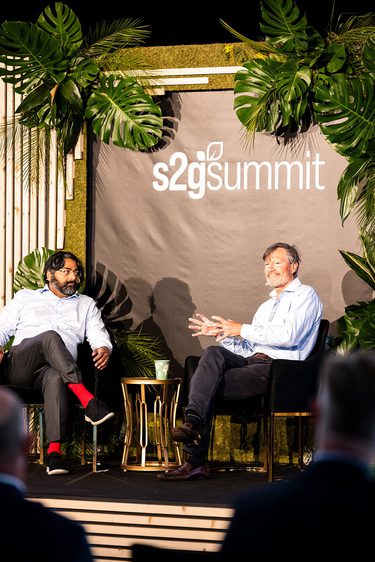
Changing Capital Markets
Investment and Activism: Wins, Losses, and Lessons Learned
In this conversation with S2G’s Sanjeev Krishnan, Jeff Ubben, Founder and Managing Partner at Inclusive Capital Partners, reflected on his nearly four-decade journey as a public market investor, highlighting the transformative changes in capitalism and shareholder activism. Ubben recounted the shift from an era dominated by retail investors to one where institutional voices, like mutual funds, began to wield significant influence. By the early 2000s, he and his peers had successfully pushed for a more active role as shareholders, addressing under-managed portfolios and balance sheets.
However, by 2015, Ubben grew concerned with the overemphasis on short-term gains at the expense of long-term societal good. Ubben’s investment philosophy has always been anchored in a five- to ten-year horizon, as exemplified by his strategic shift from coal to renewables at a power company he owned shares in, favoring sustainable transformation over immediate gains. The conversation also delved into the complexities of achieving a just transition within the energy sector. Ubben emphasized the necessity of harnessing the entire economy’s resources, including large corporations, to address energy poverty and ensure a comprehensive transition.
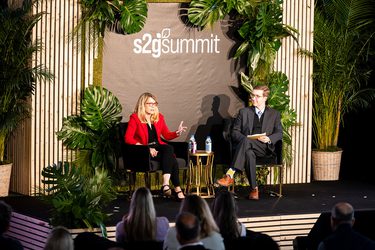
Living Laboratory: Bridging Private Sector and Policy to Bring Strategy to Life
Jennifer Morris, CEO of The Nature Conservancy (TNC), joined Howard W. Buffett, Professor at Columbia University, to discuss the imperative of bridging the private sector with policy to advance global conservation goals. Morris detailed TNC’s evolution from a small group of women in 1941 to one of the largest conservation organizations globally. With dual objectives of protecting biodiversity and realizing the value of nature, TNC’s approach is grounded in science and leverages market mechanisms. Morris underscored the necessity of private sector engagement, noting that nature represents 30 percent of the climate solution, yet receives only 8 percent of investment. Highlighting the $700 billion annual funding gap for nature and biodiversity, Morris emphasized that governance and philanthropy alone are insufficient, necessitating robust private sector participation.
The afternoon of Summit also included a portion where attendees were divided into three tracks: Oceans, Energy, and Food and Ag. Each track featured a welcome presentation from S2G managing directors followed by presentations and panels covering a wide range of topics from AI’s role in agriculture and oceans, nutrition at the forefront of health, closing the loop on clean energy, and maritime decarbonization. Keep an eye out for upcoming deep dives into these sessions on our blog and podcast.
Photo credits: dietzstudio.com


